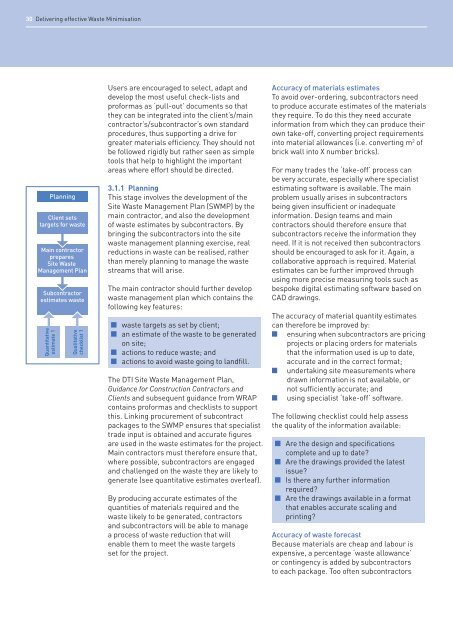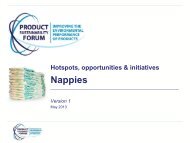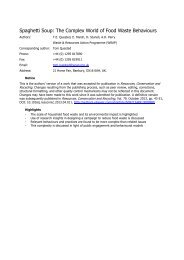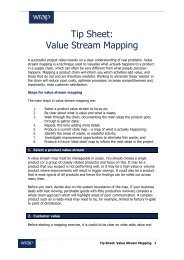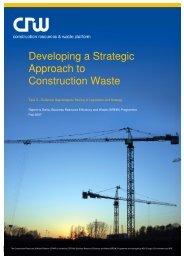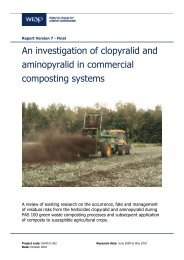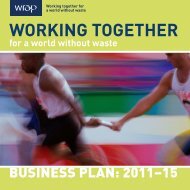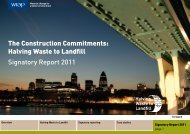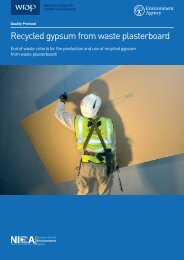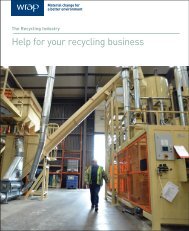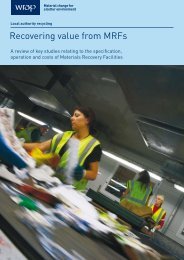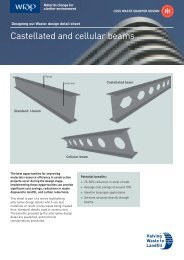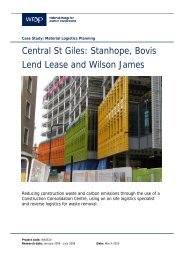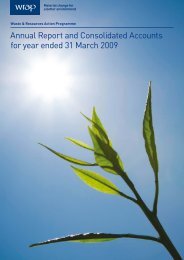Delivering effective Waste Minimisation - Wrap
Delivering effective Waste Minimisation - Wrap
Delivering effective Waste Minimisation - Wrap
Create successful ePaper yourself
Turn your PDF publications into a flip-book with our unique Google optimized e-Paper software.
30 <strong>Delivering</strong> <strong>effective</strong> <strong>Waste</strong> <strong>Minimisation</strong><br />
Planning<br />
Client sets<br />
targets for waste<br />
Main contractor<br />
prepares<br />
Site <strong>Waste</strong><br />
Management Plan<br />
Subcontractor<br />
estimates waste<br />
Quantitative<br />
estimate 1<br />
Qualitative<br />
checklist 1<br />
Users are encouraged to select, adapt and<br />
develop the most useful check-lists and<br />
proformas as ‘pull-out’ documents so that<br />
they can be integrated into the client’s/main<br />
contractor’s/subcontractor’s own standard<br />
procedures, thus supporting a drive for<br />
greater materials efficiency. They should not<br />
be followed rigidly but rather seen as simple<br />
tools that help to highlight the important<br />
areas where effort should be directed.<br />
3.1.1 Planning<br />
This stage involves the development of the<br />
Site <strong>Waste</strong> Management Plan (SWMP) by the<br />
main contractor, and also the development<br />
of waste estimates by subcontractors. By<br />
bringing the subcontractors into the site<br />
waste management planning exercise, real<br />
reductions in waste can be realised, rather<br />
than merely planning to manage the waste<br />
streams that will arise.<br />
The main contractor should further develop<br />
waste management plan which contains the<br />
following key features:<br />
■ waste targets as set by client;<br />
■ an estimate of the waste to be generated<br />
on site;<br />
■ actions to reduce waste; and<br />
■ actions to avoid waste going to landfill.<br />
The DTI Site <strong>Waste</strong> Management Plan,<br />
Guidance for Construction Contractors and<br />
Clients and subsequent guidance from WRAP<br />
contains proformas and checklists to support<br />
this. Linking procurement of subcontract<br />
packages to the SWMP ensures that specialist<br />
trade input is obtained and accurate figures<br />
are used in the waste estimates for the project.<br />
Main contractors must therefore ensure that,<br />
where possible, subcontractors are engaged<br />
and challenged on the waste they are likely to<br />
generate (see quantitative estimates overleaf).<br />
By producing accurate estimates of the<br />
quantities of materials required and the<br />
waste likely to be generated, contractors<br />
and subcontractors will be able to manage<br />
a process of waste reduction that will<br />
enable them to meet the waste targets<br />
set for the project.<br />
Accuracy of materials estimates<br />
To avoid over-ordering, subcontractors need<br />
to produce accurate estimates of the materials<br />
they require. To do this they need accurate<br />
information from which they can produce their<br />
own take-off, converting project requirements<br />
into material allowances (i.e. converting m 2 of<br />
brick wall into X number bricks).<br />
For many trades the ‘take-off’ process can<br />
be very accurate, especially where specialist<br />
estimating software is available. The main<br />
problem usually arises in subcontractors<br />
being given insufficient or inadequate<br />
information. Design teams and main<br />
contractors should therefore ensure that<br />
subcontractors receive the information they<br />
need. If it is not received then subcontractors<br />
should be encouraged to ask for it. Again, a<br />
collaborative approach is required. Material<br />
estimates can be further improved through<br />
using more precise measuring tools such as<br />
bespoke digital estimating software based on<br />
CAD drawings.<br />
The accuracy of material quantity estimates<br />
can therefore be improved by:<br />
ensuring when subcontractors are pricing<br />
projects or placing orders for materials<br />
that the information used is up to date,<br />
accurate and in the correct format;<br />
undertaking site measurements where<br />
drawn information is not available, or<br />
not sufficiently accurate; and<br />
using specialist ‘take-off’ software.<br />
The following checklist could help assess<br />
the quality of the information available:<br />
■ Are the design and specifications<br />
complete and up to date<br />
■ Are the drawings provided the latest<br />
issue<br />
■ Is there any further information<br />
required<br />
■ Are the drawings available in a format<br />
that enables accurate scaling and<br />
printing<br />
Accuracy of waste forecast<br />
Because materials are cheap and labour is<br />
expensive, a percentage ‘waste allowance’<br />
or contingency is added by subcontractors<br />
to each package. Too often subcontractors


